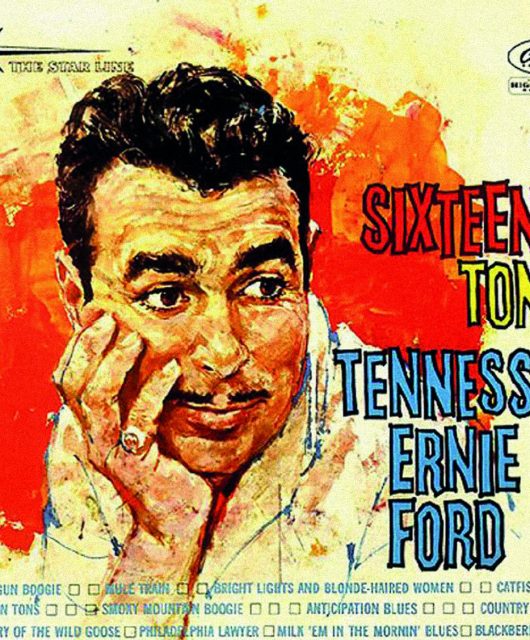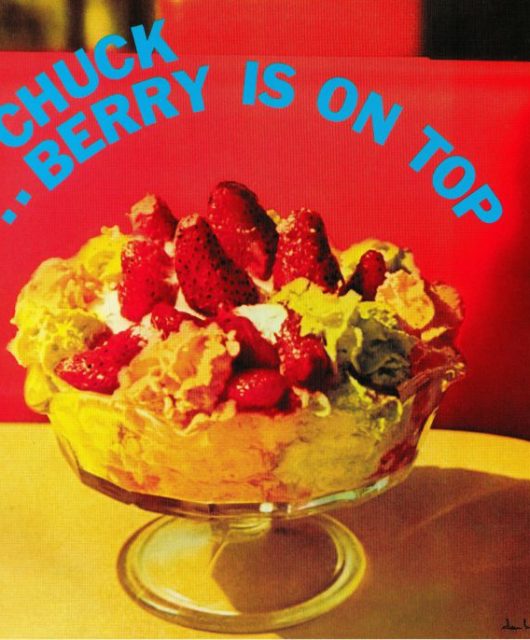Although his roots lay in country, on a hot streak beginning with Honky Tonk Man in 1956, Johnny Horton cut several rockabilly classics. The album of the same name, released after his tragic early death in a car crash in 1960, included several of the best of them… By Jack Watkins
Incidentals surrounding the death in a road accident of Johnny Horton, caused by an automobile collision with a drunk driver on a bridge outside the Texas town of Milano on 5 November 1960, have a bizarre, almost eerie quality.
Horton had a strong belief in spiritualism, and was so obsessed by the notion he was going to die in a car accident that he’d even practised driving his vehicle into a ditch in preparation for the moment.
He’d apparently tried to cancel his last show in fear of what lay ahead. The previous month he had visited the country singer and songwriter Merle Kilgore, who had penned one of his best rockers, The Wild One, as well as one of his big saga ballads, Johnny Reb.
Horton had remarked: “I gotta tell ya, old John ain’t gonna be around much longer. I don’t know how or why, but I’ll be gone before the month rolls by.”
Another friend, Johnny Cash, who shared his fascination with Americana and the spiritual quality of the landscapes of the American West, recalled how three months before Horton’s death he’d woken from a dream in which he was walking to his funeral.
At least Horton went out on top. After a decade of striving, he’d notched his second country chart No.1 the previous year with the folksy saga ballad The Battle of New Orleans. This had also crossed over and topped the Billboard pop chart.
It registered in the Top 20 in Britain and might have gone further, had not Lonnie Donegan’s cover swept past it and soared to No.1. North To Alaska, the theme song that Horton sang for the John Wayne movie which premiered within days of his death, became a posthumous hit on both sides of the Atlantic.
As with any much-mourned, recently-departed artist, Horton’s catalogue was mined in the months after his passing. Columbia issued the Honky Tonk Man album in early 1962, around the same time a reissue of the title track made a minor entry at the foot of the US pop charts.
It was the first Horton LP to feature a sizeable quota of the rockabilly, or up-tempo, material that had put his career on a new footing when he began recording for the label in 1956.
It’s true that Horton belongs in that sometimes suspiciously regarded clutch of country singers who tried to hop onto the rock’n’roll bandwagon in the mid-50s in the hope of getting a hit. Nevertheless, Johnny transitioned better than most, and a sizeable batch of songs he recorded between 1956 and 1959 have since been accorded rockabilly classic status.
Horton was already a charismatic live performer, having joined the Louisiana Hayride in 1953, where he became one of its mainstays. A handsome man with a guitar, beautifully attired in western shirts, he was an early admirer of Elvis’ Hayride appearances, forecasting he was going to be “bigger than Sinatra or Crosby.”
Likeable as he was, Horton was of an older generation than Elvis. He was born in 1925, the same year as Bill Haley, and had struggled to sell records. In a bid to improve his fortunes and finally secure a hit, he brought in Tillman Franks as his manager.
Franks, as well as playing upright bass with Webb Pierce, one of the great country hitmakers of the 1950s, had a reputation as a nurturer of talent. Horton, whose nickname the ‘Singing Fisherman’ reflected his preference for taking off with a rod and tackle into the wilderness above singing, tended to lack direction. But Franks’ energetic tutelage would tighten up his act and keep him focused in studio sessions.
Franks engineered Horton’s deal on the Columbia label and when the pair went into the Bradley Recording Studios in Nashville for their first session in January 1956, they were already set to go with Honky Tonk Man, a number Howard Hausey – later to record in his own right as Howard Crockett – had pitched to Horton.
The artist had only needed Hausey to play the bridge to realise this could be the one to break him beyond a straight country audience.
However, Franks had doubts about his own ability to bring off the clicking, percussive rockabilly slap bass effects, and so brought in Elvis’ bassist Bill Black. Franks recalled: “I could slap the bass, but I couldn’t play it like Bill. Elvis said we could take Bill, but if anyone asked who was playing bass, we should say it was me.”
If Black’s big bass sound was one of the most striking aspects of the record, also important was the work of two of Nashville’s most dependable sidemen, Grady Martin and Harold Bradley, part of what would become known as the Music Row ‘A-team’.
While the unassuming Bradley’s acoustic rhythm guitar would be a vital, if often overlooked, contributor to the infectiously chugging rhythms of many of the Horton rockers, Martin’s electric lead guitar defined them.
Although barely 27 at the time of the session, the Tennessee local was well established. What is remarkable about a guitarist so steeped in country was how quickly he was able to step forward in the studio with relatively little preparation and fashion the most perfect riffs and fills for rock’n’roll material.
Most famous among rockabilly fanatics was his magical work with Johnny Burnette and the Rock ‘N Roll Trio, yet the Horton Honky Tonk Man session predated that by six months.
As for Horton, aged 30, he was a touch on the mature side for singing rockabilly, and he never adopted the more outrageous vocal tics younger rockers used. Even so, it’s noticeable that from Honky Tonk Man onwards, he took on a more attacking vocal style, even while retaining the essentially breezy, optimistic tones that, whatever his inner phobias, were a reflection of his outwardly genial personality.
Honky Tonk Man was well received by both critics and record buyers, and gave Horton his first hit, though it nearly
didn’t happen. Producer Don Law disliked the song, and with Faron Young eager to record it, Franks had to work hard on Law to release it as a single.
Its follow-up seven-inch, I’m A One-Woman Man, recorded at the same session and also featured on the album, did just as well. With its chugging beat and Martin’s minimalist licks, Horton seemed to have found the rockin’ formula from the word go.
Of the other tracks on the album that were hits for Johnny, I’m Coming Home emerged from a later Nashville session in 1956 for which Horton and Franks once again called upon the services of Black. As was the case on many occasions, this was a joint compositional effort from Horton and Franks.
It ranks as one of the most exciting of Johnny’s rockers, the musicians sustaining immense tension across a single chord throughout the track’s two-minute, three-second running time.
Even at his most animated, Horton’s happy vocal intonations were never going to frighten the horses, but Martin’s throbbing, low-string guitar playing had the menace of a lean and mean gunslinger. There’s a resemblance on this recording to his later playing on the Rock ‘N Roll Trio’s The Train Kept A Rollin’.
I Got A Hole In My Pirogue, a more laid-back number which Franks had suggested Horton slow from its originally intended quicker rhumba tempo, was subsequently put on the B-side.
She Knows Why, released as the flipside to The Woman I Need (Honky Tonk Mind) – the latter is on the LP – was recorded in a 1957 session on which Lightning Chance, a member of Marty Robbins’ road band for many years, did the bass work. Tommy Tomlinson, in the car when Horton was killed and who himself lost a leg in the tragedy, played rhythm guitar.
It was Tomlinson who was tasked with replicating Martin’s riffs in Horton’s road band. She Knows Why is a perfect example of a song that straddles the boundary between country and rock. Goodbye Lonesome, Hello, Baby Doll, was from the same session, but was making its first appearance on the album, as was the straight country song Everytime I’m Kissing You.
Oddly, two of the album’s best songs, Honky Tonk Hardwood Floor and The Wild One, paired in 1957 on surely one of Horton’s strongest singles, never charted. Honky Tonk Hardwood Floor was not a Horton original, having first been recorded by Jess Willard in 1951. Johnny retained the barroom piano, and the percussive foot-tapping sound, but Martin’s electric guitar intro immediately upped the excitement level, as did Horton’s growly vocal.
Martin’s playing on the The Wild One was mesmeric. A song about a loner moving from town to town, with a reference to a “cycle speedin’ through the night”, the guitar, presumably, was replicating the machine sound, though the galloping tempo has a western feel.
Other tracks reflected Horton’s later flirtation with up-tempo, light-hearted folksy material, with Ole Slew-Foot and Sleepy-Eyed John both posthumous releases.
But the gentle Leon Payne ballad They’ll Never Take Her Love From Me, originally a hit for Hank Williams, suggests that had Horton lived, as he approached middle age he might have moved into Jim Reeves-style Nashville Sound territory. He had the voice for it. As Tillman Franks said: “Of all the people I’ve managed, I think Johnny had the most talent. He could really sing. He would put everything he had into it.”






